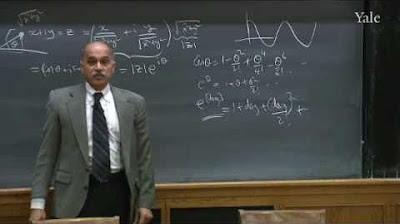AC Circuits: Crash Course Physics #36
TLDRThis video explains alternating current (AC) circuits, describing how alternating voltages and currents constantly change direction. It introduces key concepts like peak and root mean square (RMS) values to quantify AC signals. It then analyzes how circuit components like resistors, inductors and capacitors respond differently to AC sources due to phase shifts. Overall, it provides a technical overview of AC circuit analysis while relating concepts to analogies like driving a car, culminating with an explanation of how voltage divides across different components connected in series.
Takeaways
- 😊 Alternating currents change direction constantly, so values like voltage and current are described using peak and RMS (root mean square) measurements.
- 🔌 Resistors, capacitors and inductors each behave differently in AC circuits regarding current and voltage phase relationships.
- ⚡ Inductors oppose changes in current by inducing an opposing voltage, causing current to lag voltage in AC circuits.
- 💧 Capacitors store charge, so current leads voltage in AC circuits as the capacitor acts like a small voltage source.
- 🔋 In a series AC circuit, voltage drops across all components equals the total supplied voltage.
- 😀 AC electricity allows transmission of power over long distances unlike DC.
- 🌀 Inductors consist of coils designed to maximize self-inductance through magnetic flux.
- ⏱ Inductors have a time constant that determines how quickly current rises or falls over time.
- 🔥Only resistors dissipate power as heat in AC circuits. Other components have voltage drops.
- 💡 Concepts of AC circuits will be important in understanding how light works.
Q & A
What are the key variables used to describe alternating currents and voltages?
-The peak current and peak voltage are used, along with sine functions related to the system's frequency, to express the constantly changing current and voltage values in AC circuits.
How is power calculated for AC circuits?
-You can use the power equation for DC circuits, substituting RMS (root mean square) values for current and voltage, to find the average power consumed over time.
What is self-inductance in an AC circuit?
-Self-inductance refers to the induction of an opposing EMF in an inductor, caused by the changing current. This opposes and regulates the flow of current.
How do inductors behave when connected to a DC voltage source?
-The current rises gradually over time instead of immediately, due to the inductor opposing sudden changes. The time to reach steady state depends on the time constant.
Why do capacitors and inductors cause current and voltage to be out of phase in AC circuits?
-In inductors, induced EMF opposes changes in current, causing current to lag voltage. In capacitors, stored charge causes current to lead voltage.
How can you calculate voltage drops across components in an AC circuit?
-Add up the individual voltage drops across the resistor, inductor and capacitor at each point in time. The peaks occur at different times but always sum to the source voltage.
Which AC circuit component dissipates power as heat?
-The resistor is the only component that turns some electrical energy into heat. Inductors and capacitors have negligible resistance.
What is the time constant in an LR circuit with an inductor?
-The time constant tau equals the inductance L divided by the resistance R. It determines how quickly the current rises to maximum or falls to zero.
Why is there a delay when you turn a device with an inductor on or off?
-The inductor opposes sudden changes in current, so turning the voltage on/off doesn't immediately start/stop current flow.
What topics related to electricity will be covered next?
-Upcoming topics will relate electricity and magnetism to light, building on the principles of electromagnetism already covered.
Outlines
🤔 Understanding Alternating Current Circuitry
Introduces alternating currents, explaining how AC voltage and current constantly change over time. Discusses mathematical representations of AC values like peak and RMS currents. Explains the need to adjust DC circuit equations when working with AC circuits.
😮 Inductors and Their Role in AC Circuits
Explains how inductors work, including how they oppose changes in current over time. Discusses inductors in DC circuits and their time constants. Explains behavior of inductors in AC circuits, including phase relationships and voltage drops.
🧐 Bringing It All Together in an AC Circuit
Summarizes phase relationships in AC circuits with resistors, inductors and capacitors. Explains how voltage drops across each component affect the overall voltage supplied. Concludes with a summary of key AC circuit concepts covered.
Mindmap
Keywords
💡Alternating current
💡Peak current
💡RMS
💡Inductor
💡Capacitor
💡Phase
💡Voltage drop
💡Electromagnetism
💡Resonance
💡Impedance
Highlights
AC circuits have constantly changing voltages and currents, described using peak and RMS values.
RMS current and voltage can be used in DC circuit equations to calculate power for AC circuits.
Inductors oppose changes in current with induced electromagnetic forces.
In DC circuits with inductors, current increases and decreases gradually based on a time constant.
In AC circuits, current through a resistor is in phase with voltage, but inductors and capacitors cause phase shifts.
Inductor current lags voltage by 90 degrees in AC circuits.
Capacitor current leads voltage by 90 degrees in AC circuits.
Only resistors dissipate power as heat in AC circuits.
Voltage drops across all components in an AC circuit add up to the source voltage.
Inductors and capacitors affect how much voltage is supplied to other components.
AC circuits with inductors, capacitors and resistors have phase shifted voltage drops that sum to the source voltage.
Inductors in a circuit can cause a delay when a device is switched on or off.
The current in a circuit with an inductor depends on the maximum possible current and a time constant.
An inductor in a DC circuit continues to generate current for a time after the battery is removed.
Learn more about electricity, magnetism and light to understand concepts like induction and phase shifting.
Transcripts
5.0 / 5 (0 votes)
Thanks for rating:





